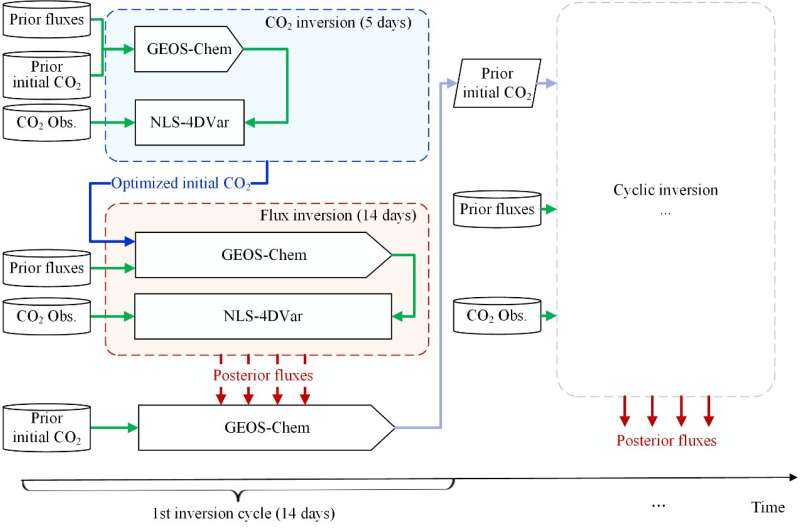Constraint of satellite CO2 retrieval on the global carbon cycle from a Chinese atmospheric inversion system
Scientists from the Institute of Tibetan Plateau Research, Chinese Academy of Sciences developed an atmospheric inversion system GONGGA (Global ObservatioN-based system for monitoring Greenhouse GAes) to infer CO2 sources and sinks from atmospheric CO2 observations.
In the study published in Science China Earth Sciences, GONGGA assimilated Orbiting Carbon Observatory-2 (OCO-2) satellite column CO2 retrievals during the period 2015–2019 and compared their estimates to five other state-of-the-art inversions. The global net terrestrial carbon sink (net biome productivity, NBP) was estimated to be 1.03±0.39 petagrams of carbon per year (PgC yr−1); this estimate is consistent with Global Carbon Project and other satellite-based inversions, but slightly lower than the surface-based inversions of 1.46–2.52 PgC yr−1. In the regional distribution, GONGGA estimated a weak northern uptake of 1.30 PgC yr−1 and weak tropical release of −0.26 PgC yr−1, consistent with multiple independent lines of evidence.
During the 2015–2016 El Niño event, the tropical land biosphere released a significant amount of CO2 and was mainly responsible for a higher global CO2 growth rate. The northern extratropics, on the contrary, was an anomalously high carbon sink during the same period, due to the concurrent extreme Northern Hemisphere greening, partially offsetting the tropical carbon losses.
The satellite constraint from GONGGA refines the current understanding of flux partitioning between northern and tropical terrestrial regions.
More information:
Zhe Jin et al, Constraint of satellite CO2 retrieval on the global carbon cycle from a Chinese atmospheric inversion system, Science China Earth Sciences (2023). DOI: 10.1007/s11430-022-1036-7
Citation:
Constraint of satellite CO2 retrieval on the global carbon cycle from a Chinese atmospheric inversion system (2023, March 28)
retrieved 28 March 2023
from https://phys.org/news/2023-03-constraint-satellite-co2-global-carbon.html
This document is subject to copyright. Apart from any fair dealing for the purpose of private study or research, no
part may be reproduced without the written permission. The content is provided for information purposes only.

Scientists from the Institute of Tibetan Plateau Research, Chinese Academy of Sciences developed an atmospheric inversion system GONGGA (Global ObservatioN-based system for monitoring Greenhouse GAes) to infer CO2 sources and sinks from atmospheric CO2 observations.
In the study published in Science China Earth Sciences, GONGGA assimilated Orbiting Carbon Observatory-2 (OCO-2) satellite column CO2 retrievals during the period 2015–2019 and compared their estimates to five other state-of-the-art inversions. The global net terrestrial carbon sink (net biome productivity, NBP) was estimated to be 1.03±0.39 petagrams of carbon per year (PgC yr−1); this estimate is consistent with Global Carbon Project and other satellite-based inversions, but slightly lower than the surface-based inversions of 1.46–2.52 PgC yr−1. In the regional distribution, GONGGA estimated a weak northern uptake of 1.30 PgC yr−1 and weak tropical release of −0.26 PgC yr−1, consistent with multiple independent lines of evidence.
During the 2015–2016 El Niño event, the tropical land biosphere released a significant amount of CO2 and was mainly responsible for a higher global CO2 growth rate. The northern extratropics, on the contrary, was an anomalously high carbon sink during the same period, due to the concurrent extreme Northern Hemisphere greening, partially offsetting the tropical carbon losses.
The satellite constraint from GONGGA refines the current understanding of flux partitioning between northern and tropical terrestrial regions.
More information:
Zhe Jin et al, Constraint of satellite CO2 retrieval on the global carbon cycle from a Chinese atmospheric inversion system, Science China Earth Sciences (2023). DOI: 10.1007/s11430-022-1036-7
Citation:
Constraint of satellite CO2 retrieval on the global carbon cycle from a Chinese atmospheric inversion system (2023, March 28)
retrieved 28 March 2023
from https://phys.org/news/2023-03-constraint-satellite-co2-global-carbon.html
This document is subject to copyright. Apart from any fair dealing for the purpose of private study or research, no
part may be reproduced without the written permission. The content is provided for information purposes only.
